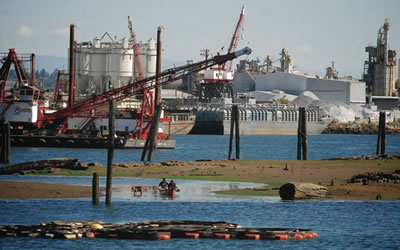Health Impact Assessment: Proposed Cleanup Plan for the Lower Duwamish Waterway Superfund Site

Researchers in our department partnered with two nonprofit groups, Just Health Action and the Duwamish River Cleanup Coalition/Technical Advisory Group, to assess the potential health impacts of the Duwamish River Cleanup on Tribes and people who use the Duwamish River or live or work nearby.
The health impact assessment (HIA) focuses on health changes that may result from the proposed cleanup and makes recommendations about how to minimize health impacts, maximize health benefits, and reduce health disparities in the affected populations.
Final HIA Report
The Final HIA report produced by the research team can be used to inform local decision-makers, especially City of Seattle, King County, and Port of Seattle. The research team also produced detailed technical reports for each of the four populations (Residents, Tribes, Fishers, and Workers) potentially impacted by the Duwamish Cleanup. An additional technical reports provide information about EPA-proposed institutional controls and the HIA resources and methods.
Executive Summary
Final Technical Reports:
- Populations:
- Local residents
- Tribes
- Subsistence (non-tribal) fishers
- Workers and employment in local industries: Part A (report) and Part B (evidence base and references)
- Institutional Controls
- HIA resources and methods
Background
More than a century of industrial and urban wastes have contaminated water, sediments, beaches, fish, and shellfish in the lower Duwamish River with a mix of 41 toxic chemicals. In 2001, the EPA placed 5.5 miles of the lower Duwamish River on the Superfund National Priorities List. A risk assessment identified four chemicals of most concern for human health: polychlorinated biphenyls (PCBs), carcinogenic polycyclic aromatic hydrocarbons (cPAHs), arsenic, and dioxins and furans. The major pathways of concern are resident fish or shellfish consumption and shoreline or sediment contact.
The EPA released its Proposed Cleanup Plan for overall site cleanup on February 28, 2013, and accepted public comment on the Plan until June 13, 2013. The EPA expects to issue a final cleanup order in 2014.
Reports
The HIA was reported in three stages:
- Advance HIA Report: This report was produced in May 2013 to inform stakeholders and members of the public during the EPA public comment period.
- HIA Public Comment Report: This report was submitted to the EPA on June 13, 2013, as formal public comment on the Proposed Cleanup Plan.
- Final HIA Report: This report was produced in October 2013 to inform local decision-makers, especially City of Seattle, King County, and Port of Seattle
Advance HIA Report
HIA Public Comment Report
Duwamish HIA Project Authors
University of Washington School of Public Health
William Daniell, Associate Professor
Jonathan Childers, graduate student
Amber Lenhart (MPH, Environmental and Occupational Health, 2013)
Duwamish River Cleanup Coalition/ Technical Advisory Group
BJ Cummings, Community Health Projects Manager
Just Health Action
Linn Gould, Executive Director
Acknowledgments and Disclaimer
This project and report is supported by a grant from the Health Impact Project, a collaboration of the Robert Wood Johnson Foundation and The Pew Charitable Trusts; and also by the Rohm & Haas Professorship in Public Health Sciences, sponsored by the Rohm & Haas Company of Philadelphia.
The views expressed are those of the authors and do not necessarily reflect the views of the Health Impact Project, The Pew Charitable Trusts, the Robert Wood Johnson Foundation, or the Rohm & Haas Company.
Additional Resources
- About the Lower Duwamish Waterway Superfund Site: this website includes information about the Lower Duwamish Waterway Superfund Site and other materials related to its history, cleanup, and other relevant information.
- Environmental Protection Agency’s (EPA) Proposed Cleanup Plan
- EPA Proposed Cleanup Plan, Appendix A: Source Control Strategy
- EPA Proposed Cleanup Plan, Appendix B: Environmental Justice Analysis: the EPA, at the request of communities near the Duwamish, conducted an environmental justice analysis of the cleanup options and their potential impacts on these communities.
- Duwamish Valley Cumulative Health Impacts Analysis (pdf): Just Health Action and the Duwamish River Cleanup Coalition/Technical Advisory Group conducted a study of the cumulative health impacts in the Duwamish Valley relative to the rest of Seattle. It considers environmental exposures, socioeconomic factors, and scientifically established indicators of health. The full report on cumulative health impacts in the Duwamish Valley.
Find Out More about Health Impact Assessment
- HIA Guide (Bhatia)
- Health Impact Project